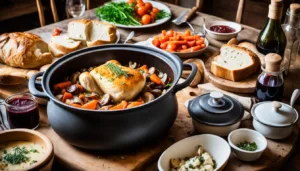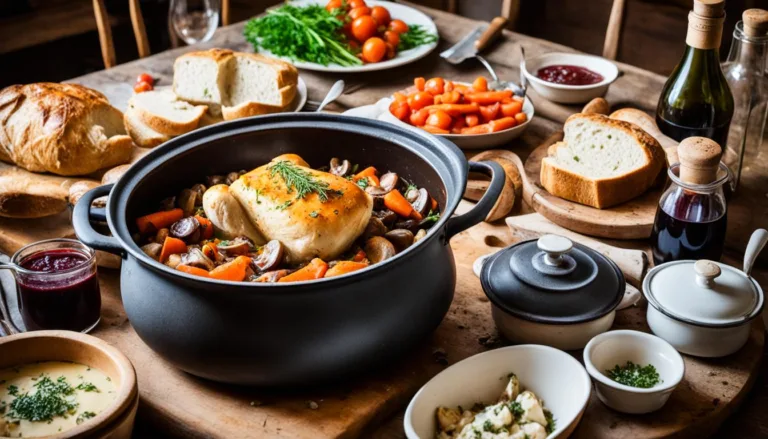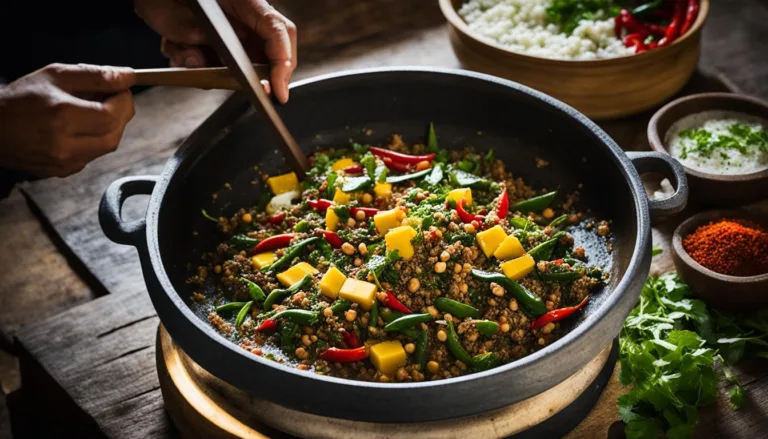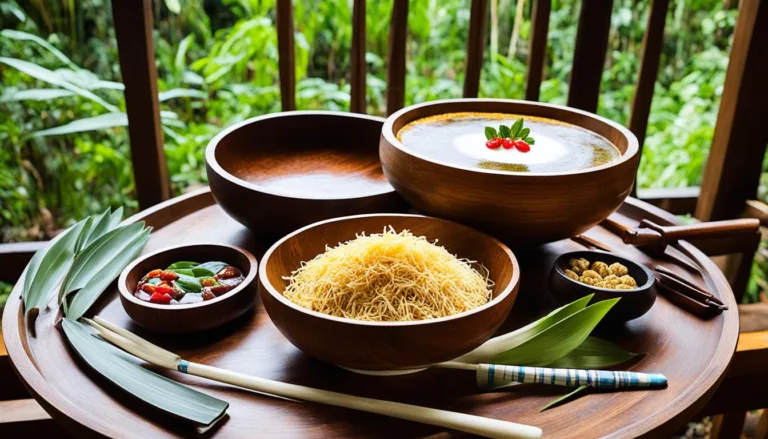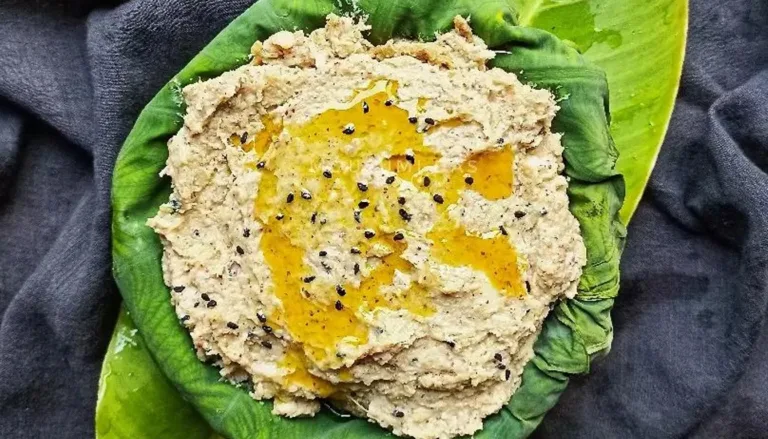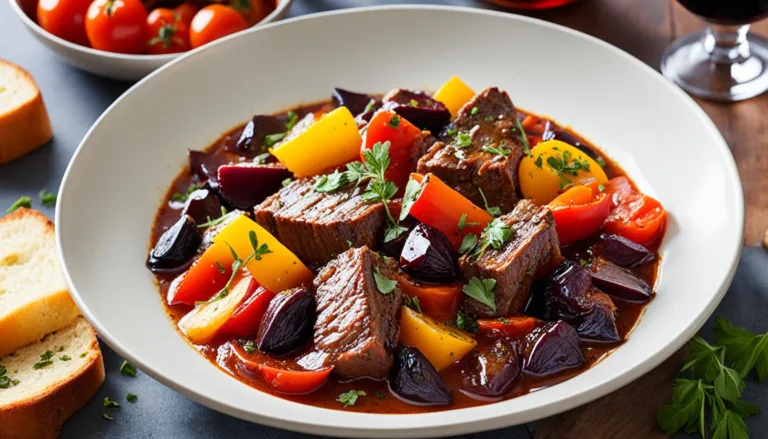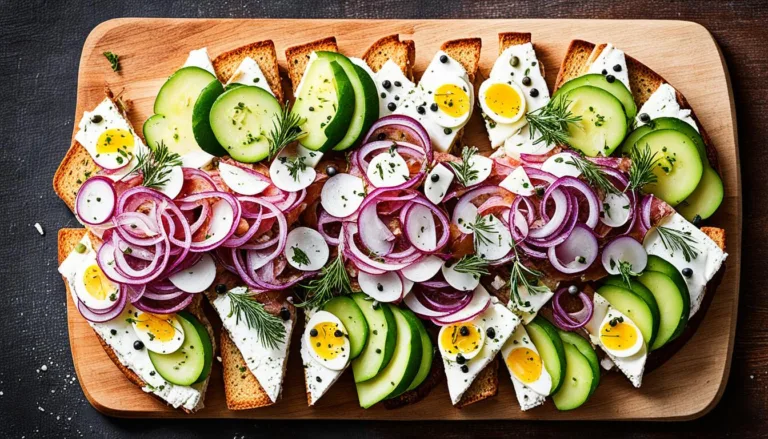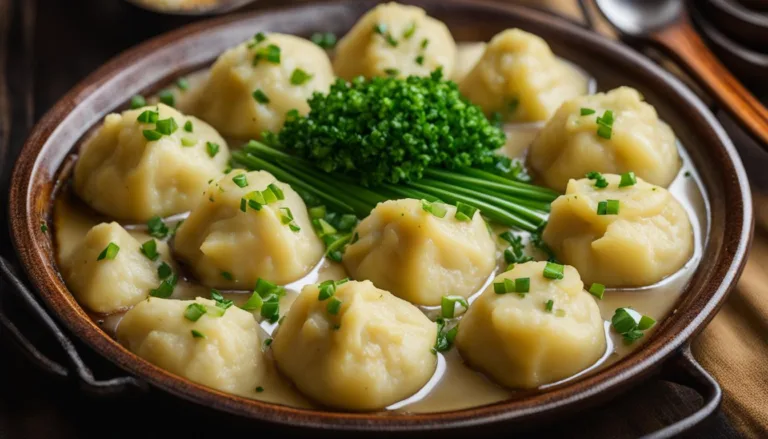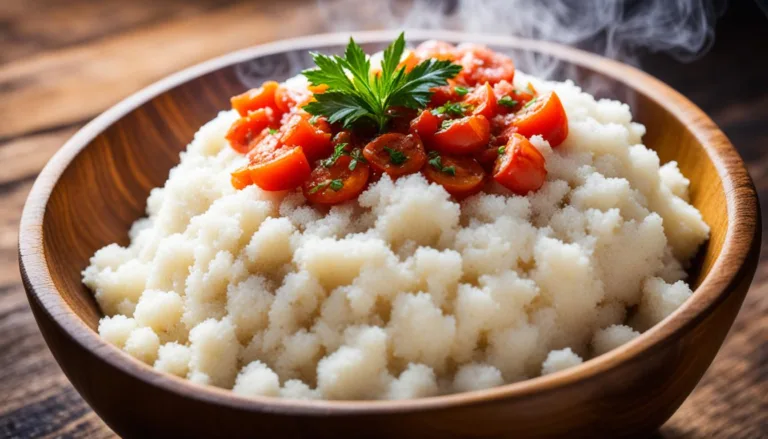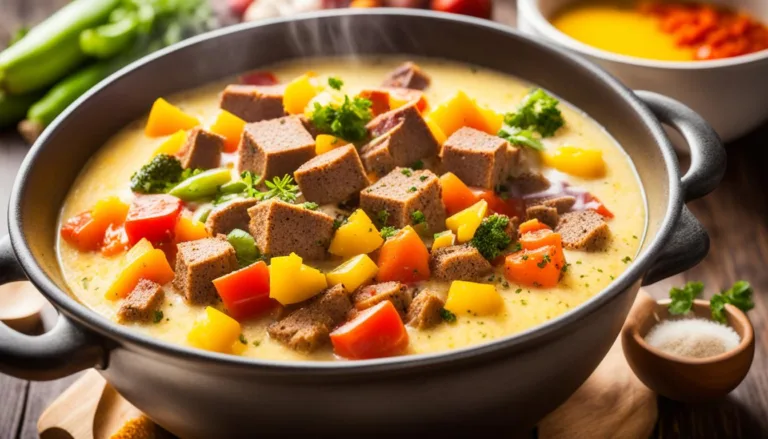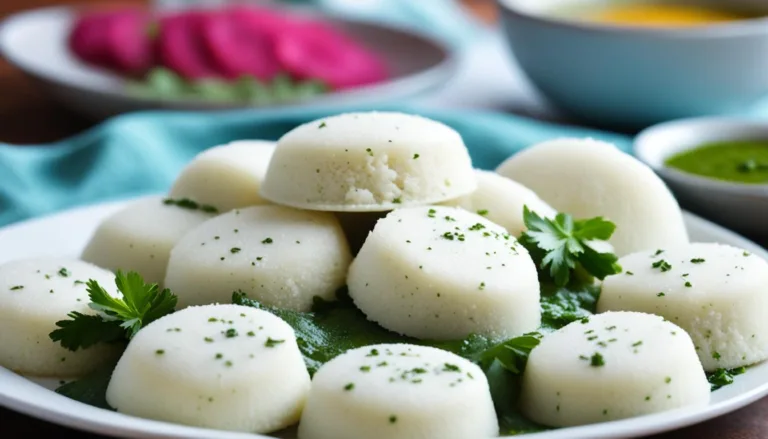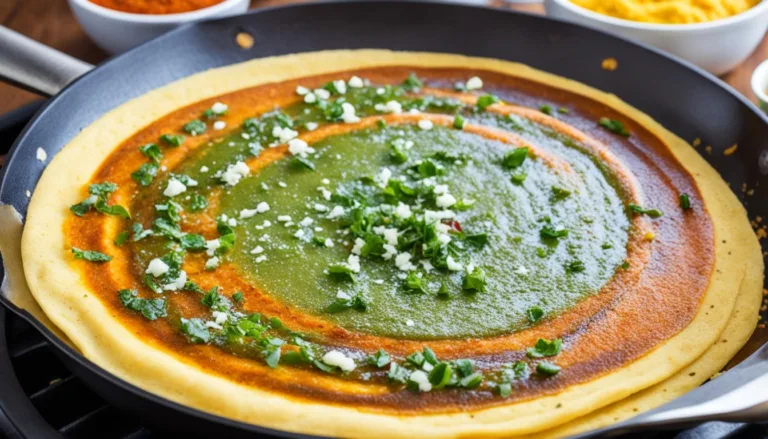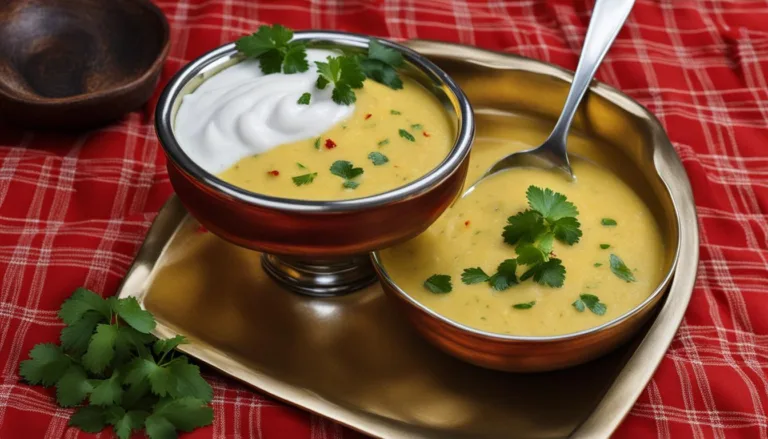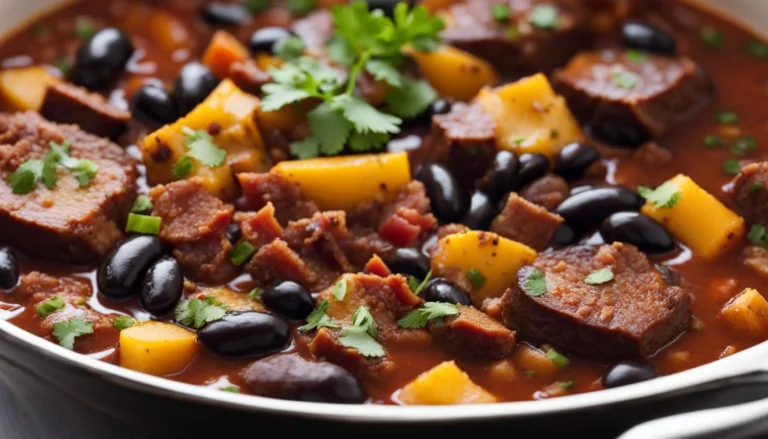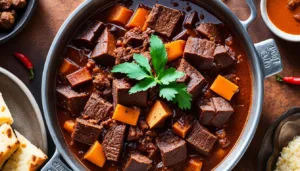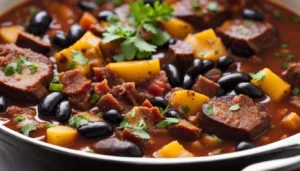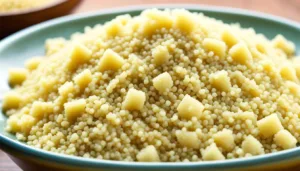Welcome to our comprehensive guide on making easy fondue without a pot! Whether you’re hosting a last-minute gathering or simply want a cozy night in, we’ve got you covered. In this guide, we will explore various ways to create delicious fondue without the need for traditional equipment. So, let’s dive in and discover the secrets to a flavorful and smooth fondue experience!
Table of Contents
Key Takeaways:
- Learn how to make delicious fondue without a fondue pot
- Discover alternative methods and equipment for fondue making
- Choose the perfect cheese blend for your fondue
- Master the art of creating an easy fondue base with wine and cheese
- Explore alternative heat sources for melting cheese
Navigating the Delicious World of Fondue Without Traditional Equipment
Fondue is known for its communal and sociable nature, but not everyone has access to a traditional fondue pot. In this section, we will discuss alternative methods and equipment that can be used to achieve the same delicious results. From using a heavy-bottomed pan to crockpots and double boilers, we’ll explore different options that can help you create a memorable fondue experience.
While a fondue pot may be the traditional choice, there are numerous alternatives that can be just as effective. A heavy-bottomed pan is an excellent option. Its thick construction helps distribute heat evenly, preventing the cheese from scorching. Simply heat the pan on low to medium heat and stir the ingredients until smooth and creamy.

If you prefer a hands-off approach, a crockpot is perfect for slow and steady heating. Set it to a low or warm setting and periodically stir the cheese mixture to avoid clumping. This method allows you to keep the fondue warm throughout your gathering, ensuring a consistent texture and temperature.
For those concerned about precision heating, a double boiler provides a gentle and controlled environment. Fill the bottom pot with water and bring it to a simmer. Place the second pot with the cheese mixture on top, allowing the indirect heat to slowly melt the cheese without the risk of burning.
These alternative fondue methods offer flexibility and convenience, allowing you to enjoy the delightful experience of fondue without traditional equipment. Experiment with different techniques to find the one that suits your preferences and resources. The goal is to create a smooth, flavorful, and communal fondue experience that will be a hit at any gathering.
The Perfect Fondue Cheese Blend
Choosing the Right Cheeses
The selection of cheeses for your fondue is crucial in achieving the perfect blend of flavors. When choosing cheeses, opt for varieties that melt smoothly and have a good balance of flavors. Here are some tips to help you choose the right cheeses:
- Consider using a combination of cheeses such as Gruyère, Emmental, and Fontina for a classic Swiss fondue.
- Experiment with different types of cheeses like Cheddar, Gouda, or Brie to add unique flavor profiles to your fondue.
- Make sure to include a cheese with a stronger flavor to add depth and complexity to the blend.
- Ask your local cheesemonger for recommendations or try different cheeses to find your favorite combination.
Remember, the key to a delicious fondue cheese blend is balancing flavors and textures, so don’t be afraid to get creative and try new combinations!
Adjusting Cheese Quantities for Texture
The texture of your fondue can greatly impact the overall experience. To achieve the desired consistency, you may need to adjust the quantities of cheese used in your blend. Here are some guidelines to help you achieve the perfect texture:
- If your fondue is too thick and clumpy, add more liquid, such as wine or broth, to thin it out.
- If your fondue is too runny, add more cheese to thicken it. Gradually add small amounts of cheese until you reach the desired consistency.
- For a silky-smooth texture, grate or finely shred the cheese before melting it. This allows the cheese to melt more evenly and creates a creamy texture.
Remember to adjust the cheese quantities gradually and taste as you go until you achieve the desired texture. With a little experimentation, you’ll find the perfect balance of cheeses and achieve a fondue with a creamy and velvety consistency.
How to Make Fondue Without a Fondue Pot
Making fondue without a traditional fondue pot is easier than you might think. With alternative equipment such as a heavy-bottomed pan or a crockpot, you can still enjoy a delicious fondue experience without the need for a specialized pot. Let us guide you through the process from start to finish!
First, gather all the ingredients for your fondue. This typically includes cheese, wine or other liquid, and seasonings. You can choose from a variety of cheese options such as Gruyère, Emmental, or Cheddar, depending on your preference.
Pro Tip: For a smooth and creamy fondue, it’s important to shred or grate the cheese before melting.
Once you have your ingredients ready, it’s time to select the appropriate alternative equipment. A heavy-bottomed pan or a crockpot will work well for melting the cheese. These options provide even heat distribution, ensuring that your fondue doesn’t burn or stick to the bottom.
To make fondue in a heavy-bottomed pan:
- Place the pan over low to medium heat.
- Add the shredded cheese and liquid (wine, broth, or beer) to the pan.
- Stir continuously until the cheese has completely melted and the mixture is smooth.
- Season with spices and herbs according to your taste.
If you prefer using a crockpot:
- Set the crockpot to a low or medium setting.
- Add the cheese and liquid to the pot.
- Cover and allow the cheese to melt slowly, stirring occasionally.
- Once the cheese has melted and the fondue is smooth, adjust the heat to keep it warm.
Remember to keep an eye on the heat to avoid overheating or scorching the cheese. It’s important to maintain a low and steady heat to achieve the desired consistency.
Once your fondue is ready, transfer it to a fondue serving dish or keep it in the crockpot for communal dipping. Serve with an assortment of dippers such as bread cubes, vegetables, or meats.

Now you can enjoy a delightful fondue experience without the need for a fondue pot. Whether you’re hosting a gathering or simply craving a cozy night in, this alternative method will surely impress your guests and satisfy your taste buds. Bon appétit!
Creating an Easy Fondue Base with Wine and Cheese
The base of a great fondue is a combination of wine and cheese. In this section, we will delve into the importance of acidity in fondue and how it contributes to the overall flavor profile. We’ll also discuss the role of cornstarch in creating a smooth and consistent texture for your fondue base.
Understanding the Role of Acidity in Fondue
Acidity is a crucial element in creating a well-balanced fondue base. The addition of wine brings a tangy and bright flavor that complements the richness of the cheese. The acidity helps to cut through the richness, resulting in a more enjoyable and flavorful fondue experience. It adds complexity and depth to the overall taste, enhancing the overall dining experience.
When choosing a wine for your fondue base, opt for dry white wines such as Chardonnay, Sauvignon Blanc, or Pinot Grigio. These wines provide the right amount of acidity without overwhelming the cheese flavors. Experiment with different wine varieties to find the perfect balance that suits your taste preferences.
The Importance of Cornstarch for Smooth Consistency

Cornstarch is a key ingredient in creating a smooth and creamy consistency for your fondue base. It acts as a thickening agent, preventing the cheese from separating and creating a lumpy texture. When heated, cornstarch absorbs moisture and forms a gel-like substance, providing a smooth and velvety texture to the fondue.
To incorporate cornstarch into your fondue base, start by tossing the grated cheese with cornstarch before adding it to the wine. This step helps the cheese melt evenly and prevents clumping. Gradually add the cheese mixture to the heated wine, stirring constantly until the cheese has fully melted and the fondue reaches the desired consistency.
It’s essential to remember that cornstarch should be used sparingly to avoid a starchy taste. Start with a small amount, and if you prefer a thicker fondue, gradually add more cornstarch until you achieve the desired thickness.
Creating an easy fondue base with wine and cheese allows you to elevate your fondue experience by enhancing the flavors and ensuring a smooth consistency. Understanding the role of acidity and incorporating cornstarch in your fondue base will help you create a delicious and satisfying fondue that will impress your guests and make your fondue night truly memorable.
Alternative Heat Sources for Melting Cheese
Melting cheese is a crucial step in making fondue. While a traditional fondue pot provides the perfect heat for melting cheese, there are alternative heat sources that can be used to achieve the same delicious results. Whether you don’t have a fondue pot or simply want to try something different, these options will ensure you can still enjoy a smooth and creamy melted cheese experience.
One alternative heat source for melting cheese is the stovetop. Simply use a heavy-bottomed pan or a saucepan and melt the cheese over low heat. Stir continuously to prevent the cheese from burning or sticking to the pan. This method allows for precise temperature control, ensuring the cheese melts evenly and smoothly.
Another option is to use kitchen tools such as a microwave or oven. Place the cheese in a microwave-safe dish or an oven-safe dish and heat it in short intervals, checking and stirring the cheese between each interval. This method requires careful monitoring to prevent the cheese from overheating or becoming too liquidy.
Note: When using alternative heat sources, it’s important to remember that the cheese may not have the same consistency and texture as when melted in a fondue pot. Experimentation and adjustments may be necessary to achieve the desired fondue consistency.
By exploring these alternative heat sources, you can melt cheese without the need for a fondue pot and still enjoy a delicious fondue experience. Get creative and try different methods to find the one that works best for you.

| Alternative Heat Sources | Pros | Cons |
|---|---|---|
| Stovetop (heavy-bottomed pan or saucepan) | – Precise temperature control – Even and smooth melting | – Requires constant stirring – Limited capacity |
| Microwave | – Quick and convenient – Easy cleanup | – May require multiple intervals – Watch closely to prevent overheating |
| Oven | – Even heat distribution – Ability to melt larger quantities | – Longer melting time – Requires careful monitoring |
Specialty Cheese Options and Substitutes
While traditional cheese blends are popular choices for fondue, there is a world of specialty options and substitutes that can take your fondue experience to the next level. Whether you’re looking for a classic taste or a flavorful twist, exploring different types of cheeses can add a unique touch to your fondue.
Cow’s Milk Cheeses for a Traditional Taste
Cow’s milk cheeses are widely used in traditional fondue recipes, known for their smooth and creamy texture. They melt beautifully and have a rich, savory flavor that pairs perfectly with bread, vegetables, and other fondue dippers. Gruyère is a popular choice, known for its nutty and slightly sweet taste. Emmental, with its holey texture and mild flavor, is another great option. These cow’s milk cheeses provide a classic and authentic fondue experience.
Sheep and Goat Cheeses for a Flavorful Twist
If you’re looking to add a unique and flavorful twist to your fondue, consider using specialty sheep and goat cheeses. These cheeses bring a more pronounced and distinct flavor profile to the fondue. Sheep’s milk cheeses like Pecorino Romano and Manchego offer a rich and slightly tangy taste that can elevate your fondue. Goat cheeses, such as Chèvre or Bucheron, provide a creamy and earthy flavor that adds complexity to the dish. Experimenting with different sheep and goat cheeses allows you to create a fondue that is truly your own.
| Type of Cheese | Flavor | Melting Characteristics |
|---|---|---|
| Gruyère (Cow’s Milk) | Nutty, slightly sweet | Smooth melting |
| Emmental (Cow’s Milk) | Mild, slightly fruity | Holey texture, melts well |
| Pecorino Romano (Sheep’s Milk) | Rich, tangy | Melts well, adds complexity to flavor |
| Manchego (Sheep’s Milk) | Nutty, slightly sweet | Smooth melting, enhances fondue taste |
| Chèvre (Goat’s Milk) | Creamy, earthy | Soft texture, melts well |
| Bucheron (Goat’s Milk) | Mild, slightly tangy | Soft and crumbly texture, melts smoothly |
Pairing Wine and Beer with Your Fondue
Fondue is often enjoyed with a glass of wine or beer. The right alcoholic pairing can enhance the flavors of your fondue and elevate your dining experience. In this section, we will provide guidance on choosing the perfect wine or beer to complement your fondue. We’ll explore the different flavors and profiles that harmonize well with various cheese blends and offer suggestions for non-alcoholic alternatives for those who prefer to enjoy their fondue without alcohol.
- Classic Coq au Vin Recipe – French Comfort Food

- Authentic Ema Datshi Recipe | Taste of Bhutan

- Creamy Chicken Butter Masala Recipe – Taste the special and the best!

Choosing the Right Alcoholic Pairings
When it comes to wine pairing with fondue, there are a few key considerations to keep in mind. The general rule is to match the intensity and flavors of the wine with those of the cheese. Here are some popular wine options that pair well with fondue:
- White Wine: A dry, crisp white wine like Chardonnay or Sauvignon Blanc can complement a variety of cheese blends. The acidity and fruity notes of these wines balance the richness of the cheese.
- Red Wine: For a heartier fondue, a medium-bodied red wine like Pinot Noir or Merlot can be a great choice. The tannins and fruitiness of these wines help cut through the creamy texture of the cheese.
- Sparkling Wine: Sparkling wines like Champagne or Prosecco can add a touch of elegance to your fondue experience. Their effervescence can cleanse the palate between bites and enhance the overall enjoyment.
When it comes to beer pairing with fondue, there are also several options that can complement the flavors of the cheese. Here are some popular beer styles to consider:
- Lager: A light and crisp lager can offer a refreshing contrast to the richness of the cheese. Pilsners or pale lagers are excellent choices that won’t overpower the flavors of the fondue.
- Amber Ale: The caramel and toasty notes of an amber ale can provide a nice complement to the cheese. The medium body and balanced flavors make it a versatile option for fondue.
- Belgian Tripel: If you’re looking for a beer with a little more complexity, a Belgian tripel can be a great choice. The fruity and spicy flavors can harmonize well with the flavors of the fondue.
Non-Alcoholic Substitutes for Fondue
Not everyone prefers to enjoy their fondue with alcohol. Thankfully, there are non-alcoholic alternatives that can still enhance the fondue experience. Here are a few suggestions:
- Fruit Juice: A glass of freshly squeezed fruit juice, such as apple or pear, can provide a refreshing and fruity accompaniment to your fondue.
- Mocktails: Mocktails made with sparkling water, fruit puree, and herbs can offer a fun and flavorful alternative to alcoholic beverages.
- Herbal Infusions: Herbal teas or infusions made with delicate flavors like chamomile or mint can provide a soothing and aromatic pairing with your fondue.
Regardless of your preference, the key is to choose a pairing that brings out the best in your fondue and creates a delightful culinary experience.
Accompaniments and Dippers to Complete Your Fondue Experience

Fondue is best enjoyed with a variety of accompaniments and dippers. Whether you prefer the classic options or are looking for something unique, there are plenty of choices to enhance your fondue experience.
Traditional Fondue Dippers
When it comes to traditional fondue dippers, there are some tried-and-true options that never disappoint. Consider these delicious choices:
- Bread cubes
- Vegetables like broccoli, cauliflower, and cherry tomatoes
- Meat such as chicken, beef, or shrimp
- Boiled potatoes
These classic dippers provide a fantastic combination of flavors and textures that pair perfectly with melted cheese or chocolate fondue.
Unique and Unconventional Dippers
If you’re looking to add a fun twist to your fondue experience, consider trying some unique and unconventional dippers. These options can elevate your fondue to a whole new level:
- Apple or pear slices
- Pretzels or pretzel bread
- Mini meatballs
- Pickle slices
- Spicy popcorn
These unexpected dippers bring exciting flavors and textures that will surprise and delight your taste buds.
| Dippers | Traditional Choices | Unique and Unconventional |
|---|---|---|
| Bread cubes | Apple or pear slices | |
| Vegetables | Pretzels or pretzel bread | |
| Meat | Mini meatballs | |
| Boiled potatoes | Pickle slices | |
| Spicy popcorn |
Preventing Common Fondue Faux Pas
Fondue is a delightful culinary experience that brings people together. However, it can sometimes present challenges, such as cheese clumping and separation. Don’t worry, though! With the right techniques, you can avoid these common fondue faux pas and ensure a smooth and velvety fondue.
Avoiding Cheese Clumping and Separation
One of the most frustrating issues in fondue is when the cheese starts to clump or separate, compromising the smooth texture. To prevent this, here are some tips:
- Grate the cheese finely: Grating the cheese into small shreds allows it to melt evenly and prevents clumping.
- Toss the cheese with cornstarch: Coat the grated cheese in cornstarch before adding it to the pot. The cornstarch acts as a stabilizer, preventing clumping and separation.
- Gradually add the cheese: Add the cheese to the pot slowly, allowing each batch to melt completely before adding more. This ensures a smooth and consistent texture.
Following these steps will help you achieve a creamy and lump-free fondue.
Ensuring Perfect Fondue Texture
Texture plays a crucial role in the overall fondue experience. Here are some tips to ensure a perfect fondue texture:
- Stir constantly: Stirring the fondue continuously helps to distribute the heat evenly and prevents the cheese from sticking or burning.
- Use low heat: Avoid high heat settings that can cause the cheese to scorch or curdle. Gentle heat allows the cheese to melt slowly and maintain a smooth consistency.
- Add liquid gradually: If your fondue becomes too thick, gradually add small amounts of liquid (such as wine or broth) while stirring until you achieve the desired consistency.
By following these tips, you can create a velvety and perfect fondue texture that will impress your guests.
Now that you have the knowledge to prevent clumping and separation and achieve a fantastic fondue texture, you’re ready to enjoy a seamless and delicious fondue experience.
Quick Fondue Solutions with Common Kitchen Tools
If you’re in a pinch and don’t have access to specialized fondue equipment, there’s no need to worry. You can still enjoy delicious fondue using common kitchen tools that you likely already have. In this section, we’ll share quick and easy solutions for making fondue without a pot, using tools that are readily available in your kitchen.
One of the simplest alternatives to a fondue pot is using a saucepan. A heavy-bottomed saucepan can provide the necessary heat distribution to melt your cheese and keep it warm throughout your fondue experience. Just make sure to use low heat and stir frequently to prevent scorching.
If you want to take it a step further, you can also create a double boiler using a heat-safe bowl and a saucepan filled with water. This setup allows for gentle and indirect heat, which is ideal for melting cheese without burning it. Place the cheese in the bowl and set it over the simmering water. Stir continuously until the cheese is melted and smooth.
Another option is using a crockpot or slow cooker. These versatile kitchen tools can be a game-changer when it comes to making fondue. Simply add your cheese mixture to the crockpot, set it on low heat, and let it slowly melt to perfection. This method is ideal for parties and gatherings, as it keeps the fondue warm throughout the event.
No fondue forks? No problem! You can use regular skewers or even toothpicks as dippers for your fondue. Just make sure they’re long enough for easy dipping and retrieval.
Whether you opt for a saucepan, a double boiler, or a crockpot, these quick fondue solutions will allow you to enjoy the rich and flavorful experience of fondue without the need for specialized equipment. Get creative with your choice of dippers and gather your friends and family for a delightful fondue feast!
Conclusion
In conclusion, making fondue without a traditional fondue pot is entirely possible and can be just as delicious. Throughout this guide, we have explored various ways to create a flavorful and smooth fondue experience without the need for specialized equipment.
We discussed alternative methods and equipment that can be used, such as a heavy-bottomed pan, crockpots, and double boilers. We also explored how to choose the right cheeses and balance flavors and textures to create the perfect fondue cheese blend.
Furthermore, we provided step-by-step instructions on how to make fondue with alternative equipment, and we highlighted the importance of creating an easy fondue base with wine and cheese. We also discussed alternative heat sources for melting cheese and specialty cheese options that can enhance your fondue.
With our guidance on pairing wine and beer with your fondue, and suggesting a variety of accompaniments and dippers, you will be able to create a truly memorable fondue experience at home. We also provided tips on avoiding common pitfalls, achieving the perfect fondue texture, and quick solutions using common kitchen tools.
We hope you’ve found this guide helpful and that it inspires you to embark on your fondue-making adventures. So gather your ingredients, gather your friends and family, and enjoy the delightful world of fondue without the need for a pot!
FAQ
Can I make fondue without a traditional fondue pot?
Yes, you can make fondue without a traditional fondue pot. There are alternative methods and equipment that can be used to achieve the same delicious results.
How do I choose the right cheeses for my fondue?
When choosing cheeses for your fondue, it’s important to consider balancing flavors and textures. You can also adjust cheese quantities to achieve the desired consistency and texture.
How do I make fondue without a fondue pot?
Making fondue without a fondue pot is easier than you might think. You can use alternative equipment such as a heavy-bottomed pan or a crockpot. We provide step-by-step instructions in this guide.
What is the base of a great fondue?
The base of a great fondue is a combination of wine and cheese. The acidity in the wine contributes to the overall flavor profile, and cornstarch is used to create a smooth and consistent texture.
What are alternative heat sources for melting cheese?
If you don’t have a fondue pot, you can use alternative heat sources such as a stovetop, microwave, or oven to melt cheese for your fondue.
Are there specialty cheese options and substitutes for fondue?
Yes, there are specialty cheese options that can elevate your fondue experience, including cow’s milk cheeses for a traditional taste and sheep and goat cheeses for a flavorful twist.
What alcoholic pairings are recommended for fondue?
Fondue is often enjoyed with a glass of wine or beer. Choosing the right alcoholic pairings depends on the cheese blend, and we provide guidance on flavors and profiles that complement different cheeses. Non-alcoholic substitutes are also suggested.
What are some recommended accompaniments and dippers for fondue?
Traditional fondue dippers include bread cubes, vegetables, and meats. We also explore unique and unconventional dippers that can add a fun twist to your fondue experience.
How can I prevent common fondue challenges?
To avoid cheese clumping and separation, you can follow our tips for achieving a smooth and velvety fondue. We also provide tips on achieving the perfect fondue texture and consistency.
Can I make fondue without specialized equipment?
Yes, if you don’t have access to specialized fondue equipment, there are quick solutions using common kitchen tools such as saucepans and double boilers.

